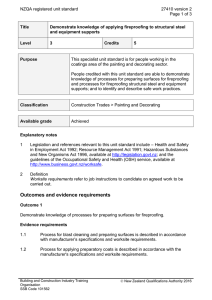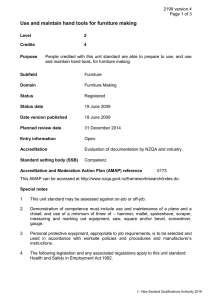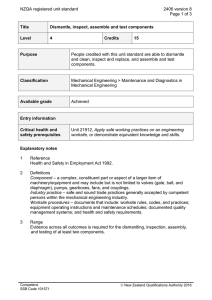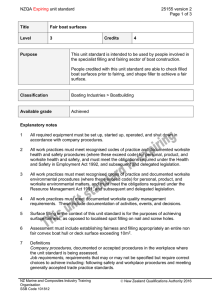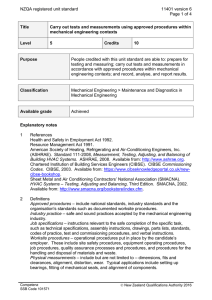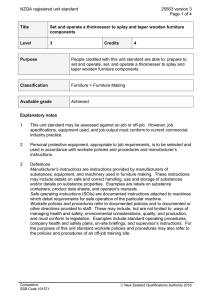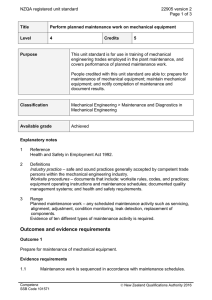NZQA registered unit standard 9789 version 4 Page 1 of 4
advertisement
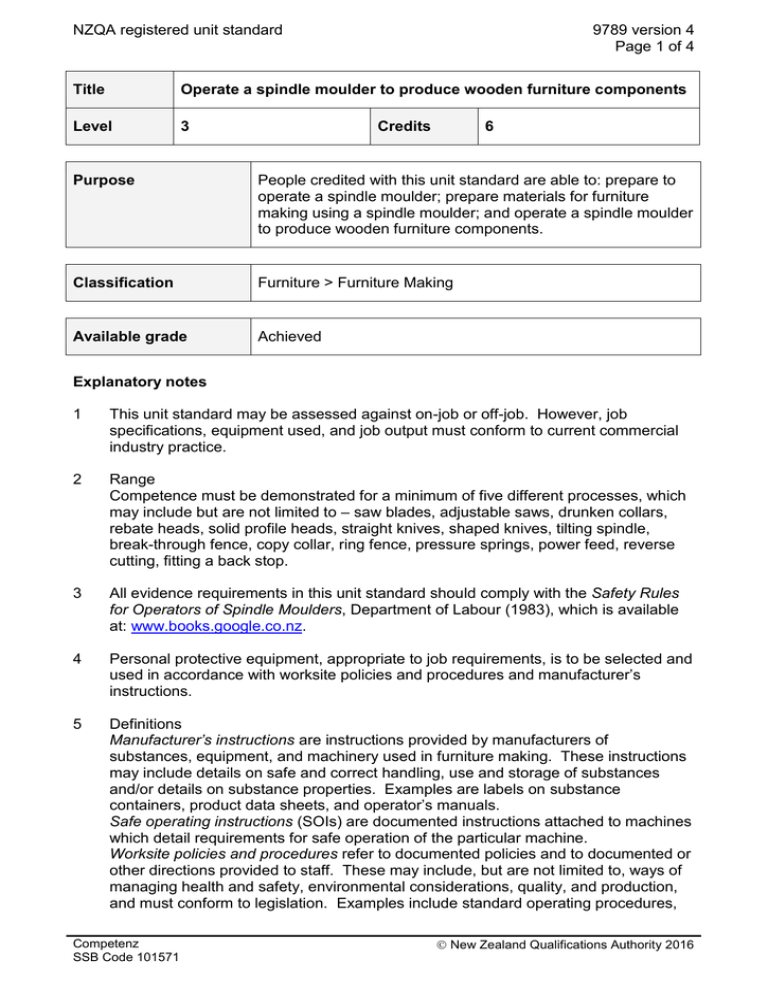
NZQA registered unit standard 9789 version 4 Page 1 of 4 Title Operate a spindle moulder to produce wooden furniture components Level 3 Credits 6 Purpose People credited with this unit standard are able to: prepare to operate a spindle moulder; prepare materials for furniture making using a spindle moulder; and operate a spindle moulder to produce wooden furniture components. Classification Furniture > Furniture Making Available grade Achieved Explanatory notes 1 This unit standard may be assessed against on-job or off-job. However, job specifications, equipment used, and job output must conform to current commercial industry practice. 2 Range Competence must be demonstrated for a minimum of five different processes, which may include but are not limited to – saw blades, adjustable saws, drunken collars, rebate heads, solid profile heads, straight knives, shaped knives, tilting spindle, break-through fence, copy collar, ring fence, pressure springs, power feed, reverse cutting, fitting a back stop. 3 All evidence requirements in this unit standard should comply with the Safety Rules for Operators of Spindle Moulders, Department of Labour (1983), which is available at: www.books.google.co.nz. 4 Personal protective equipment, appropriate to job requirements, is to be selected and used in accordance with worksite policies and procedures and manufacturer’s instructions. 5 Definitions Manufacturer’s instructions are instructions provided by manufacturers of substances, equipment, and machinery used in furniture making. These instructions may include details on safe and correct handling, use and storage of substances and/or details on substance properties. Examples are labels on substance containers, product data sheets, and operator’s manuals. Safe operating instructions (SOIs) are documented instructions attached to machines which detail requirements for safe operation of the particular machine. Worksite policies and procedures refer to documented policies and to documented or other directions provided to staff. These may include, but are not limited to, ways of managing health and safety, environmental considerations, quality, and production, and must conform to legislation. Examples include standard operating procedures, Competenz SSB Code 101571 New Zealand Qualifications Authority 2016 NZQA registered unit standard 9789 version 4 Page 2 of 4 company health and safety plans, on-site briefings, and supervisor’s instructions. For the purposes of this unit standard worksite policies and procedures may also refer to the policies and procedures of an off-job training site. Outcomes and evidence requirements Outcome 1 Prepare to operate a spindle moulder. Evidence requirements 1.1 Job specifications are obtained and explained in accordance with worksite policies and procedures. Range quantity, material, size and shape. 1.2 Machine and other equipment are safely isolated from power sources during set-up in accordance with manufacturer’s instructions. 1.3 Environmental and safety requirements are met in accordance with worksite policies and procedures. Range electrical power, lighting, ventilation, dust extraction. Outcome 2 Prepare materials for furniture making using a spindle moulder. Evidence requirements 2.1 Materials are obtained in accordance with job specifications. 2.2 Materials are checked for defects and replaced if necessary. Range any of – splits, timber shakes, grain direction, surface damage. 2.3 Materials that do not conform to job specifications are identified and disposed of in accordance with worksite policies and procedures. 2.4 Materials are delivered to machine and ergonomically positioned in accordance with worksite policies and procedures. Outcome 3 Operate a spindle moulder to produce wooden furniture components. Evidence requirements 3.1 Machine is operated in accordance with SOIs and worksite policies and procedures. Competenz SSB Code 101571 New Zealand Qualifications Authority 2016 NZQA registered unit standard 9789 version 4 Page 3 of 4 3.2 Components are monitored during operation in accordance with job specifications and worksite policies and procedures. 3.3 Possible causes of components not meeting job specifications and their corrective actions are explained in accordance with worksite policies and procedures. Range machine variation, loading of component, unclear work surface, jig damage. 3.4 Components are produced to specification and within the time limits in accordance with job specifications and worksite policies and procedures. 3.5 Machine and work area are made clean, clear, and safe in accordance with worksite policies and procedures. Planned review date 31 December 2019 Status information and last date for assessment for superseded versions Process Version Date Last Date for Assessment Registration 1 7 May 1997 31 December 2018 Review 2 26 February 2002 31 December 2018 Review 3 19 June 2009 31 December 2018 Review 4 19 March 2015 N/A Consent and Moderation Requirements (CMR) reference 0173 This CMR can be accessed at http://www.nzqa.govt.nz/framework/search/index.do. Please note Providers must be granted consent to assess against standards (accredited) by NZQA, before they can report credits from assessment against unit standards or deliver courses of study leading to that assessment. Industry Training Organisations must be granted consent to assess against standards by NZQA before they can register credits from assessment against unit standards. Providers and Industry Training Organisations, which have been granted consent and which are assessing against unit standards must engage with the moderation system that applies to those standards. Requirements for consent to assess and an outline of the moderation system that applies to this standard are outlined in the Consent and Moderation Requirements (CMR). The CMR also includes useful information about special requirements for organisations wishing to develop education and training programmes, such as minimum qualifications for tutors and assessors, and special resource requirements. Competenz SSB Code 101571 New Zealand Qualifications Authority 2016 NZQA registered unit standard 9789 version 4 Page 4 of 4 Comments on this unit standard Please contact Competenz at qualifications@competenz.org.nz if you wish to suggest changes to the content of this unit standard. Competenz SSB Code 101571 New Zealand Qualifications Authority 2016

